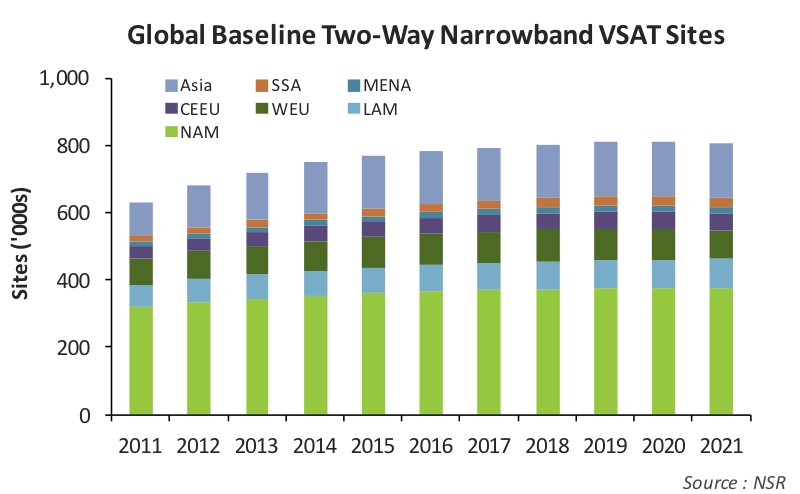Narrowband VSAT a Classic Hit
Jan 7th, 2013
by Patrick
French, NSR
The satellite industry these days almost
exclusively focuses on big-pipe broadband VSAT
services for high value segments like maritime,
oil & gas, consumer broadband, and
government-backed rural connectivity and school
networks. Yet, the December 2012 announcement
that Hughes India will connect 27,000 ATMs with
what is essentially a narrowband VSAT network is
much like hearing a great old but nearly
forgotten classic hit on the radio.
Even if the total network is allocated a few
Mbps of capacity, the average provisioning of
services like ATM networks is typically only a
few tens of Kbps per site. And because of this
low capacity requirement per site, narrowband
VSAT networks can provide a very cost effective
connectivity solution per site while at the same
time offering a superior quality of service with
uptime in excess of 99.9% and a large area of
coverage allowing all sites to be managed by a
single service provider. For anyone who has been
around the satellite industry for a while, these
attributes are about as basic to VSAT services
as a back beat is to a classic rock song.
Yet, for many of the “young generation” of
potential clients who are more inclined to tune
into the latest terrestrial services like aDSL
or 3/4G, these benefits of VSAT often go
unrecognized. The reality is that services like
3/4G or aDSL don’t actually have true universal
coverage, these services suffer from congestion
that impacts QoS, and one must typically deal
with numerous different service providers in
order to stitch together a large network with
the same service providers always trying to
blame the “other guy” for any network problems.
In the rush to use the latest “chart topper”
service, the clients often don’t know or have
forgotten just how good classic narrowband VSAT
services are and how predominant in fact they
remain even if they don’t get a lot of “play
time”.
The Indian ATM network deal is just the
latest announcement in a stream of recent
narrowband ATM/bank deals in India stretching
back two years. And it is not only in India
where these deals are occurring. Indonesia and
Brazil, among others, have seen a string of ATM
and “bank agent” networks installed in the last
several years. Plus lottery networks, another
classic narrowband VSAT service, often count as
among the largest VSAT networks installed in any
country. By NSR’s count, there are at least
200,000 lottery sites using VSAT for
connectivity services in the USA alone, and the
Camelot lottery network in the UK is the single
largest VSAT network in all of Europe. Other
significant lottery networks can be found in
Latin America and Africa, and additional lottery
networks are in the works in a number of
countries.
In the latest Broadband Satellite Markets
11th Edition
study, NSR forecasts that the global installed
base of two-way narrowband VSAT sites will
increase by over 170,000 in the coming years
with the majority of the growth coming for ATM
and lottery networks plus a smaller contribution
for other services such as point-of-sale and Low
Data Rate/SCADA monitoring networks. NSR does
believe that growth in the global installed base
of narrowband VSAT sites will slow in the
future. However, this decline is mainly an issue
of existing networks being upgraded to broadband
provisioning. In fact, narrowband VSAT clients
often are a critical pool of future broadband
VSAT users. This is exactly what has occurred in
the last few years in the retail segment as many
former narrowband point-of-sale networks have
been upgraded to broadband services as more
applications were added to the VSAT network.

Bottom Line
Narrowband VSAT may be a golden oldie to
some, but they still offer a cost effective
solution with a high quality of service and a
solid value for the end client. Plus, they can
be a source for future industry growth as
clients start with a simple narrowband VSAT
network to meet a core need and then expand and
add capacity and capability as new applications
and services are added to the network. Like any
classic hit, narrowband VSAT can still be a
great service for the latest generation of VSAT
clients.